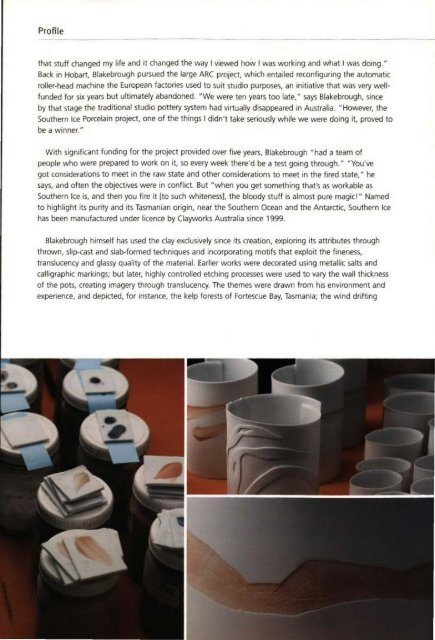The Journal of Australian Ceramics Vol 51 No 3 November 2012
Create successful ePaper yourself
Turn your PDF publications into a flip-book with our unique Google optimized e-Paper software.
Pr<strong>of</strong>ile<br />
that stuff changed my life and it changed the way I viewed how I was working and what I was doing."<br />
Back in Hobart, Blakebrough pursued the large ARC project, which entailed reconfiguring the automatic<br />
roller-head machine the European factories used to suit studio purposes, an initiative that was very wellfunded<br />
for six years but ultimately abandoned. "We were ten years too late," says Blakebrough, since<br />
by that stage the traditional studio pottery system had virtually disappeared in Australia. "However, the<br />
Southern Ice Porcelain project, one <strong>of</strong> the things I didn't take seriously while we were doing it, proved to<br />
be a winner."<br />
With significant funding for the project provided over five years, Blakebrough "had a team <strong>of</strong><br />
people who were prepared to work on it, so every week there'd be a test going through." "You've<br />
got considerations to meet in the raw state and other considerations to meet in the fired state," he<br />
says, and <strong>of</strong>ten the objectives were in conflict. But "when you get something that's as workable as<br />
Southern Ice is, and then you fire it [to such whiteness], the bloody stuff is almost pure magic!" Named<br />
to highlight its purity and its Tasmanian origin, near the Southern Ocean and the Antarctic, Southern Ice<br />
has been manufactured under licence by Clayworks Australia since 1999.<br />
Blakebrough himself has used the clay exclusively since its creation, exploring its attributes through<br />
thrown, slip-cast and slab-formed techniques and incorporating motifs that exploit the fineness,<br />
translucency and glassy quality <strong>of</strong> the material. Earlier works were decorated using metallic salts and<br />
calligraphic markings; but later, highly controlled etching processes were used to vary the wall thickness<br />
<strong>of</strong> the pots, creating imagery through translucency. <strong>The</strong> themes were drawn from his environment and<br />
experience, and depicted, for instance, the kelp forests <strong>of</strong> Fortescue Bay, Tasmania; the wind drifting

















